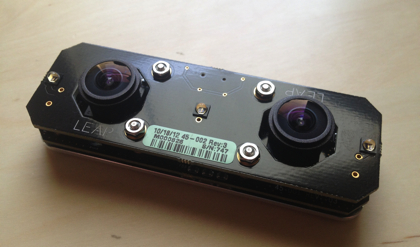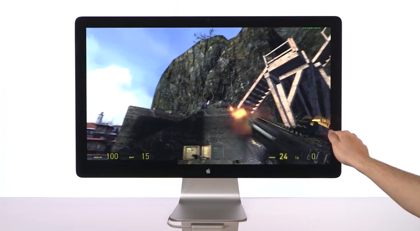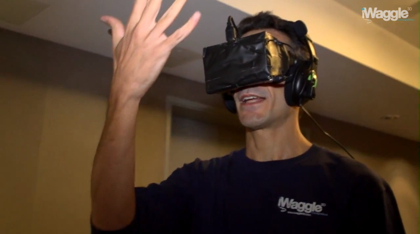A Leap in interfacing
While the Oculus Rift has sparked a revival of the virtual reality dream, there is another side of the equation that remains to be solved. Control interfaces.
There's various reasons why traditional controls are not optimal for VR gaming. Immersion definitely takes a hit if you have to handle a gamepad to do anything other than enjoy the view. And that's if you can even find the controller after putting on a headset that blocks out the real world. And while a seasoned gamer will have no problems feeling their way around a gamepad, even less people can work a keyboard for an extensive period of time without seeing the keys.
Unless you're playing a vehicle sim, where specialized peripherals are perfect, you really want to do away with hardware input entirely. This is where the upcoming gadget Leap Motion is showing a lot of promise.
It's like touch without touching
The Leap is a little gadget the size of a small candy bar that tracks your hands and let's you control your computer using hand gestures. It's like a very focused Xbox Kinect, letting you track individual finger movements within an accuracy of a fraction of a millimeter.
Leap tracks your movements down to a 1/100th of a millimeter
When the Leap was announced in May with a suggested retail price of 70 US dollars, it almost sounded too good to be true. The tech seemed too awesome to be that cheap, and many people were skeptical about their ability to make it available by this winter as they promised.
But they seem to be right on schedule, with developer kits already being shipped out to a selection of the 40,000 developers who have applied for one. The company has already demonstrated a range of uses for the Leap available out of the box, but allowing developers to program for the device will allow for limitless applications of the new tech. Leap Motion have said they expect to have shipped up to 5000 devices to developers by Thanksgiving.
 Developer version of the Leap, showing the two cameras used to track motion. Source: monleap.fr
Developer version of the Leap, showing the two cameras used to track motion. Source: monleap.fr
Leap Motion also recently hired a former Apple Director, Michael Zagorsek, as their new VP of Product Marketing. Zagorsek was responsible for interactive marketing for every product launch at Apple since the first iPhone, and will be a key player in reaching out to both customers and developers for the Leap.
Is it a good fit for VR?
So it can track your fingers, but how does that translate to gaming controls? Obviously you can't just swap out your regular controls for any game and be on your merry way. With just a Leap on a desk, you're also locked in to only having your hands tracked within a certain area, and then you're back to the keyboard problem of not seeing where your hands actually are.
 Is that finger loaded?
Is that finger loaded?
But Leap Motion are not only planning to sell their little gadget to end-users, they are also trying to work with OEMs to implement their technology in other devices. This is where the possible application for the Oculus Rift seems very interesting.
Oculus founder Palmer Luckey recently had a chance to test the Leap himself and posted a quick impression on the MTBS3D forums:
it is very sweet, much better than I thought it would be. Silky smooth, latency is imperceptible to even my trained eye, and the precision is phenomenal.
Not only a ringing endorsement, but you have to wonder whether some substantive talks were had during this meet and greet between gadget startups.
David Holz, founder of Leap Motion, also chimed in on the thread, answering questions:
How restrictive is the 8 cu.ft. volume? Will people naturally wander out of that area with an HMD on?
The Leap FOV is larger than the Oculus FOV. Given proper mounting you should be able to have your hands tracked before they even enter your virtual peripheral vision.
Mounting? Who said anything about mounting? Is that what you and Palmer were discussing, David? Ok, to be fair, the previous questions were riddled with the concept of mounting this to the Rift, but again I wonder whether this was mentioned as a real possibility when Palmer visited.
In the countless Rift hands-on videos, you'll often see the reviewer get lost in the immersion and actually try to look at their hand. If you have an Oculus Rift with Leap sensors attached to the front, you would actually be able to put your hand in front of your face, and have the game render a virtual hand.
 Person shown suffering from "forgot I'm in a game" syndrome. Source: iwaggle3d.com
Person shown suffering from "forgot I'm in a game" syndrome. Source: iwaggle3d.com
There's also no reason it would be limited to just tracking hands. Leap Motion have already shown how they can track tools like pencils. Put a gun in your hand, and you'll be able to aim realistically while seeing a virtual reproduction of the gun in your hands.
Will we see a partnership between Oculus and Leap in the future? Personally, I really hope so, because both of these techs gets my mind spinning with the possibilities for the future of VR gaming. Optimally the issues of positional tracking and movement need to be solved, but let's take it one step of the time.
 Nov 14, 2012
Nov 14, 2012 